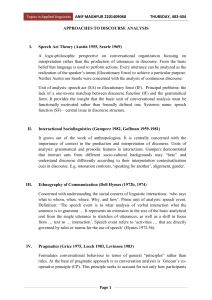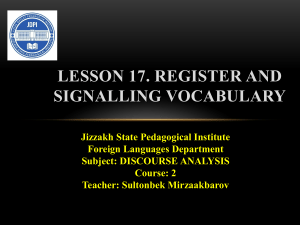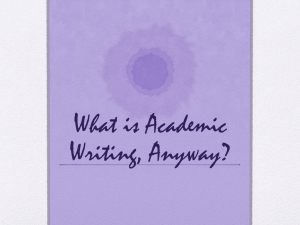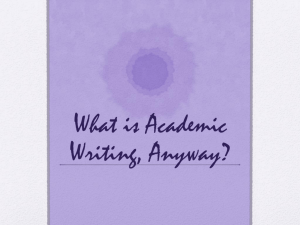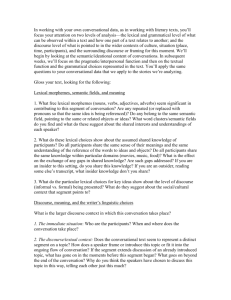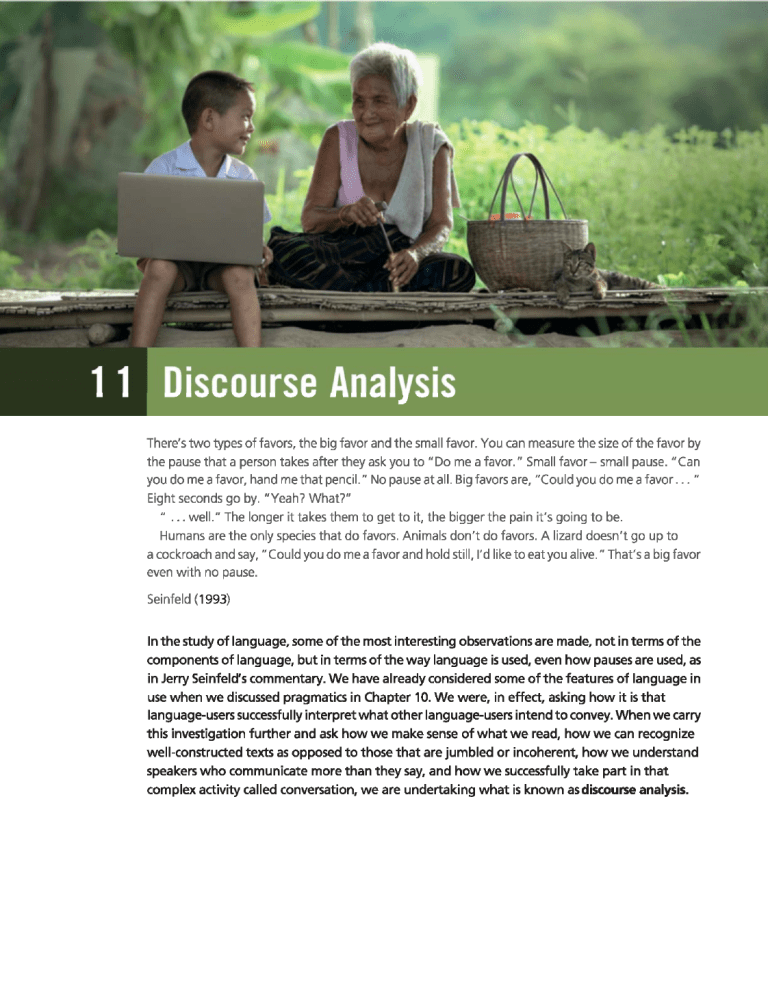
11 Discourse Analysis There's two types of favors, the big favor and the small favor. You can measure the size of the favor by the pause that a person takes after they ask you to “Do me a favor.” Small favor — small pause. “Can you do me a favor, hand me that pencil.” No pause at all. Big favors are, “Could you do me a favor... ” Eight seconds go by. “Yeah? What?" “ ... well.” The longer it takes them to get to it, the bigger the pain it's going to be. Humans are the only species that do favors. Animals don’t do favors. A lizard doesn’t go up to a cockroach and say, “ Could you do me a favor and hold still, I'd like to eat you alive.” That's a big favor even with no pause. Seinfeld (1993) In the study of language, some of the most interesting observations are made, not in terms of the components of language, but in terms of the way language is used, even how pauses are used, as in Jerry Seinfeld’'s commentary. We have already considered some of the features of language in use when we discussed pragmatics in Chapter 10. We were, in effect, asking how it is that language-users successfully interpret what other language-users intend to convey. When we carry this investigation further and ask how we make sense of what we read, how we can recognize well-constructed texts as opposed to those that are jumbled or incoherent, how we understand speakers who communicate more than they say, and how we successfully take part in that complex activity called conversation, we are undertaking what is known as discourse analysis. 168 Discourse Analysis The word discourse is usually defined as “language beyond the sentence” and so the analysis of discourse is typically concerned with the study of language in texts and conversation. In many of the preceding chapters, when we were concentrating on linguistic description, we were concerned with the accurate representation of the forms and structures. However, as language-users, we are capable of more than simply recognizing correct versus incorrect forms and structures. We can cope with fragments in newspaper headlines such as Trains collide, two die, and know that what happened in the first part was the cause of what happened in the second part. We can also make sense of notices like No shoes, no service, on shop windows in summer, understanding that a conditional relation exists between the two parts (“If you are wearing no shoes, you will receive no service”). We have the ability to create complex discourse interpretations of fragmentary linguistic messages. Interpreting Discourse We can even cope with texts, written in English, which we couldn’t produce ourselves and which appear to break a lot of the rules of the English language. Yet we can build an interpretation. The following example, provided by Eric Nelson, is from an essay by a student learning English and contains ungrammatical forms and misspellings, yet it can be understood. My Town My natal was in a small town, very close to Riyadh capital of Saudi Arabia. The distant between my town and Riyadh 7 miles exactly. The name of this Almasani that means in English Factories. It takes this name from the peopl’s carrer. In my childhood I remmeber the people live. It was very simple. Most the people was farmer. This example may serve to illustrate a simple point about the way we react to language that contains ungrammatical forms. Rather than simply rejecting the text as ungrammatical, we try to make sense of it. That is, we attempt to arrive at a reasonable interpretation of what the writer intended to convey. (Most people say they understand the “My Town” text quite easily.) It is this effort to interpret (or to be interpreted), and how we accomplish it, that are the key elements investigated in the study of discourse. To arrive at an interpretation, and to make our messages interpretable, we certainly rely on what we know about linguistic form and structure. But, as language-users, we have more knowledge than that. Cohesion We know, for example, that texts must have a certain structure that depends on factors quite different from those required in the structure of a single sentence. Some of those factors are described in terms of cohesion, or the formal ties and connections that exist within texts. There are several cohesive ties in this text. My father once bought a Lincoln convertible. He did it by saving every penny he could. That car would be worth a fortune nowadays. However, he sold it to help pay for my college education. Sometimes I think I'd rather have the convertible. We can identify connections here in the use of words to maintain reference to the same people and things throughout. There are also connections created by terms that share a common element of meaning, such as “money” and “time.” The verb tenses in the first four sentences are in the past, creating a connection between those events, in contrast to the present tense of the final sentence marking a change in time and focus. These cohesive ties are listed in Table 11.1. See Task B on page 178 for more. TABLE 11.1 COHESIVE TIES People My father— He —he —he; My-my—1-1 Things A Lincoln convertible — That car— it— the convertible Money bought - saving every penny — worth a fortune — sold — pay Time once — nowadays — sometimes Tenses past (bought) — past (did) — past (could) — past (sold) — present (think) Analysis of these cohesive ties gives us some insight into how writers structure what they want to say. However, by itself, cohesion is not sufficient to enable us to make sense of what we read. It is quite easy to create a text that has a lot of cohesive ties, but is difficult to interpret. Note that the following text has these connections in Lincoln - the car, red that color, her —she and letters — a letter. My father bought a Lincoln convertible. The car driven by the police was red. That color doesn’t suit her. She consists of three letters. However, a letter isn’t as fast as a telephone call. It becomes clear from this type of example that the “connectedness” we experience in our interpretation of normal texts is not simply based on connections between words. There must be another factor that helps us distinguish connected texts that make sense from those that do not. This factor is usually described as “coherence.” 169 170 Discourse Analysis The key to the concept of coherence (“everything fitting together well”) is not something that exists in the words or structures of discourse, like cohesion, but something that exists in people. It is people who “make sense” of what they read and hear. They try to arrive at an interpretation that is in line with their experience of the way the world is. You may have tried quite hard to make the last example fit some situation that accommodated all the details (involving a red car, a woman and a letter) into a single coherent interpretation. In doing so, you would necessarily be involved in a process of bringing other information to the text. This process is not restricted to trying to understand “odd” texts. It seems to be involved in our interpretation of all discourse. For example, you pick up a newspaper and see this headline: Woman robs bank with sandwich. As you try to build a coherent interpretation, you probably focus on the sandwich part because there is something odd about this situation. Is she just carrying a sandwich, or is she eating the sandwich (taking occasional bites), or is she acting as if the sandwich is a weapon (concealed in a bag perhaps)? Deciding which interpretation is appropriate cannot be accomplished based on only the words in the headline. We need to bring information from our experience to create a plausible situation. If you decided on the “pretend gun in bag” situation, then your coherence-creating mind would appear to be in good working order. We also depend on coherence in coping with everyday conversation. We are continually taking part in conversational interactions where a great deal of what is meant or communicated cannot Widdowson, actually be found in what is said. In this brief interaction (from 1978), there are no cohesive ties connecting the three utterances, so we must be using some other means to on is to consider the three parts of Chapter 10). These are listed on the identifying what makes it coherent make sense of it. One way to understand what is going the interaction in terms of speech acts (introduced in right, providing a way of analyzing the interaction by for the participants. ner: That’s the telephone. (She makes a request of him to perform action) uM: I'm in the bath. (He states reason why he cannot comply with request) HER: OK. (She accepts reason) If this is a reasonable analysis of what took place in the brief interaction, then it is clear that language-users must have a lot of knowledge of how conversation works that is not simply knowledge of words and sentences, but must involve familiarity with a lot of other types of structures and their typical functions. Conversation Analysis Conversation Analysis In simple terms, English conversation can be described as an activity in which, for the most part, two or more people take turns at speaking. Typically, only one person speaks at a time and there tends to be an avoidance of silence between speaking turns. (This is not true in all situations or societies.) If more than one participant tries to talk at the same time, one of them usually stops, as in the following example, where A stops until B has finished. A: Didn't you [know wh- B: [But he must've been there by two A: Yes but you knew where he was going (A small square bracket [ is conventionally used to indicate a place where simultaneous or overlapping speech occurs.) For the most part, participants wait until one speaker indicates that he or she has finished, usually by signaling a completion point. Speakers can mark their turns as complete in a number of ways: by asking a question, for example, or by pausing at the end of a completed syntactic structure like a phrase or sentence. Other participants can indicate that they want to take the speaking turn, also in a number of ways. They can start to make short sounds, usually repeated, while the speaker is talking, and often use body shifts or facial expressions to signal that they have something to say. (For more on conversation, see Task C, on page 179, and Task F on page 180) Turn-Taking There are different expectations of conversational style and different strategies of participation in conversation, which may result in slightly different conventions of turn-taking. One strategy, which may be overused by “long-winded” speakers or those who are used to “holding the floor,” is designed to avoid having normal completion points occur. We all use this strategy to some extent, usually in situations where we have to work out what we are trying to say while actually saying it. If the normal expectation is that completion points are marked by the end of a sentence and a pause, then one way to “keep the turn” is to avoid having those two markers occur together. That is, don’t pause at the end of sentences; make your sentences run on by using connectors like and, and then, so, but; place your pauses at points where the message is clearly incomplete; and preferably “fill” the pause with a hesitation marker such as er, em, uh, ah. 171 172 Discourse Analysis Pauses and Filled Pauses In the following example, note how the pauses (marked by . . .) are placed before and after verbs rather than at the end of sentences, making it difficult to get a clear sense of what this person is saying until we hear the part after each pause. A: that’s their favorite restaurant because they ... enjoy French food and when they were . .. in France they couldn’t believe it that . . . you know that they had . . . that they had had better meals back home In the next example, speaker X produces filled pauses (with em, er, you know) after having almost lost the turn at his first brief hesitation. X: well that film really was ... [wasn’t what he was good at Y: [when di- X: I'mean his other . .. em his later films were much more . . . er really more in the romantic style and that was more what what he was . . . you know . .. em best at doing Y: so when did he make that one Adjacency Pairs That last speakers because patterns. example would seem to suggest that conversation is a problematic activity where have to pay close attention to what is going on. That is not normally the case a great deal of conversational interaction follows some fairly well established When someone says Hi or Hello, we usually respond with a similar greeting. This type of almost automatic sequence is called an adjacency pair, which consists of a first part and a second part, as found in greetings, question-answer (Q ~ A) sequences, thanking and leave-taking. First part Second part you: Good mornin’. ME: Good mornin’. you: Where's Mary? you: Thanks for your help yesterday. ME: She’s at work already. ME: Oh, you're welcome. you: Okay, talk to you later. ME: Bye. These examples illustrate the basic pattern, but not all first parts are immediately followed by second parts. For example, one question may not receive its answer until after another question-answer sequence. (See Task E, on page 179, for more.) Conversation Analysis Insertion Sequences In the following example, the sequence Q2 ~ A2 comes between the first question (Q1) and its answer (Al). This is called an insertion sequence, that is, an adjacency pair that comes between the first and second parts of another pair. vou: Do you want some milk? (= Ql) Me: Is it soy milk? vou: Of course. ME: Okay, thanks. (=Q2) (= A2) (= AD In some situations, a complex structure can emerge from the effect of insertion sequences. This is often the case in “service encounters,” as in our next example. Notice how it is only in the middle of this interaction (Q3 ~ A3) that we have an adjacency pair together, while insertion sequences delay the occurrence of second parts for each of the other first parts. BuD: Can I order pizza to go? (=Q1) paN: What kind would you like? (=Q2) BUD: Do you have any special deals? (=Q3) pan: Well, you can get two veggie supremes for the price of one. (= A3) BUD: Okay, I'd like that deal. (= A2) DAN: Sure thing. We'll have that ready for you in no time. (= Al) We are not normally aware of most of these aspects of conversational structure, but speakers sometimes draw attention to the need for a second part once a first part has been uttered. In the following interaction, originally analyzed by Sacks (1972: 341), a mother immediately notices the absence of a spoken return greeting by her daughter and draws attention to the social expectation involved. WOMAN: Hi, Annie. MOTHER: Annie, don’t you hear someone say hello to you? woMAN: Oh, that’s okay, she smiled hello. MOTHER: You know you're supposed to greet someone, don’t you? ANNE: [Hangs head] Hello. The expectations we all have that certain patterns of turn-taking will occur in conversation are connected to a more general aspect of socially situated interaction, that it will be “co-operative.” This observation is actually a principle of conversation. 173 174 Discourse Analysis مهم جدا The Co-operative Principle An underlying assumption in most conversational exchanges is that the participants are co-operating with each other. This principle, plus four elements, or “maxims,” were first described by the philosopher Paul Grice (1975: 45), and are often referred to as the “Gricean maxims,” as presented in Table 11.2. TABLE 11.2 GRICEAN MAXIMS The Co-operative Principle: Make your conversational contribution such as is required, at the stage at which it occurs, by the accepted purpose or direction of the talk exchange in which you are engaged. The Quantity maxim: Make your contribution as informative as is required, but not more, or less, than is required. The Quality maxim: Do not say that which you believe to be false or for which you lack adequate evidence. The Relation maxim: Be relevant. The Manner maxim: Be clear, brief and orderly. In simple terms, we expect our conversational partners to make succinct, honest, relevant and clear contributions to the interaction and to signal to us in some way if these maxims are not being followed. It is certainly true that, on occasion, we can experience conversational exchanges in which the co-operative principle may not seem to be in operation. However, this general description of the normal expectations we have in conversation helps to explain a number of regular features in our talk. For example, during their lunch break, one woman asks another how she likes the sandwich she is eating and receives the following answer. Oh, a sandwich is a sandwich. In logical terms, this reply appears to have no communicative value since it states something obvious and hence would appear to be a tautology. Repeating a phrase that adds nothing would hardly count as an appropriate answer to a question. However, if the woman is being co-operative and adhering to the Quantity maxim about being “as informative as is required,” then the listener must assume that her friend is communicating something. Given the opportunity to evaluate the sandwich, her friend has responded without an explicit evaluation, thereby implying that she has no opinion, good or bad, to express. That is, her friend has communicated that the sandwich is not worth talking about. (See Task D, on page 179, for more.) The Co-operative Principle Hedges We can use certain types of expressions, called hedges, to show that we are concerned about following the maxims while being co-operative speakers. Hedges can be defined as words or phrases used to indicate that we are not really sure that what we are saying is sufficiently correct or complete. We can use sort of or kind of as hedges on the accuracy of our statements, as in descriptions such as His hair was kind of long or The book cover is sort of yellow. These are examples of hedges on the Quality maxim. Other examples would include the following expressions that people sometimes use as they begin a conversational contribution. As faras know ... Correct me if I'm wrong, but . .. I'm not absolutely sure, but ... We also take care to indicate that what we report is something we think or feel (not know), is possible (not certain), and may (not must) happen. Hence the difference between saying Jackson is guilty and I think it’s possible that Jackson may be guilty. In the first version, people will assume you have very good evidence for the statement. Implicatures When we try to analyze how hedges work, we usually talk about speakers implying something that is not said. Similarly, in considering what the woman meant by a sandwich is a sandwich, we decided that she was implying that the sandwich was not worth talking about. With the co-operative principle and the maxims as guides, we can start to work out how people actually decide that someone is “implying” something in conversation. Consider the following example. cArRoL: Are you coming to the party tonight? LARA: I've got an exam tomorrow. On the face of it, Lara’s statement is not an answer to Carol's question. Lara doesn’t say Yes or No. Yet Carol will interpret the statement as meaning “No” or “Probably not.” How can we account for this ability to grasp one meaning from a sentence that, in a literal sense, means something else? It seems to depend on the assumption that Lara is being relevant (Relation) and informative (Quantity). Given that Lards original answer contains relevant information, Carol can work out that “exam tomorrow” involves “study tonight,” and “study tonight” precludes “party tonight.” Thus, Lara’s contains activities. answer is an implicature not (an just a additional statement conveyed about tomorrow’s meaning) activities, concerning it tonight’s 175 176 Discourse Analysis Background Knowledge It is noticeable that, in order to analyze the conversational implicature involved in Lara’s statement, we had to describe some background knowledge (about exams, studying and partying) that must be shared by the conversational participants. Investigating how we use our background knowledge to arrive at interpretations of what we hear and read is a critical part of doing discourse analysis. The processes involved in using background knowledge can be illustrated in the following exercise (from Sanford and Garrod, 1981). Begin with these sentences: John was on his way to school last Friday. He was really worried about the math lesson. Most readers report that they think John is probably a schoolboy. Since this piece of information is not directly stated in the text, it must be an inference. Other inferences, for different readers, are that John is walking or that he is on a bus. These inferences are clearly derived from our conventional knowledge, in our culture, about “going to school,” and no reader has ever suggested that John is swimming or on a boat, though both are physically possible interpretations. An interesting aspect of the reported inferences is that readers can quickly abandon them if they do not fit in with some subsequent information. Last week he had been unable to control the class. On encountering this sentence, most readers decide that John must be a teacher and that he is not very happy. Many report that he is probably driving a car to school. It was unfair of the math teacher to leave him in charge. Suddenly, John reverts to his schoolboy status, and the inference that he is a teacher is quickly abandoned. The final sentence of the text contains a surprise. After all, it is not a normal part of a janitor’s duties. This type of text and manner of presentation, one sentence at a time, is rather artificial, of course. Yet the exercise does provide us with some insight into the ways in which we “build” interpretations of what we read by using more information than is presented in the words on the page. We actually create what the text is about, based on our expectations of what normally happens. To describe this phenomenon, researchers often use the concept of a “schema” or a “script.” Background Knowledge Schemas and Scripts A schema is a general term for a conventional knowledge structure that exists in memory. We were using our conventional knowledge of what a school classroom is like, or a “classroom schema,” as we tried to make sense of the previous example. We have many schemas (or schemata) that are used in the interpretation of what we experience and what we hear or read about. If you hear someone describe what happened during a visit to a supermarket, you don’t have to be told what is in a supermarket. You already have a “supermarket schema” (food displayed on shelves, arranged in aisles, shopping carts and baskets, check-out counter and so on). Similar in many ways to a schema is a script. A script is essentially a dynamic schema. That is, instead of the set of typical fixed features in a schema, a script has a series of conventional actions that take place. You have a script for “Going to the dentist” and another script for “Going to the movies.” » We all have versions a restaurant” script, which we can activate to make sense of this text. of an “Eating in Trying not to be out of the office for long, Suzy went into the nearest place, sat down and ordered an avocado sandwich. It was quite crowded, but the service was fast, so she left a good tip. Back in the office, things were not going well. On the basis of our restaurant script, we would be able to say a number of things about the scene and events briefly described in this short text. Although the text doesn’t have this information, we would assume that Suzy opened a door to get into the restaurant, that there were tables there, that she ate the sandwich, then she paid for it and so on. The fact that information of this type can turn up in people’s attempts to remember the text is further evidence of the existence of scripts. It is also a good indication of the fact that our understanding of what we read doesn’t come directly from what on the page, but the interpretations we create, in our minds, of Indeed, information is sometimes omitted from instructions everybody knows the script. This instruction is from a bottle of words and sentences are what we read. on the assumption that cough syrup. Fill measure cup to line and repeat every 2 to 3 hours. No, you've not just to keep filling the measure cup every 2 to 3 hours. Nor have you to rub the cough syrup on your neck or in your hair. You are expected to know the script and drink the stuff from the measure cup every 2 or 3 hours. Clearly, our understanding of what we read is not only based on what we see on the page (language structures), but also on other things that we have in mind (knowledge structures) as we go about making sense of discourse. 177

